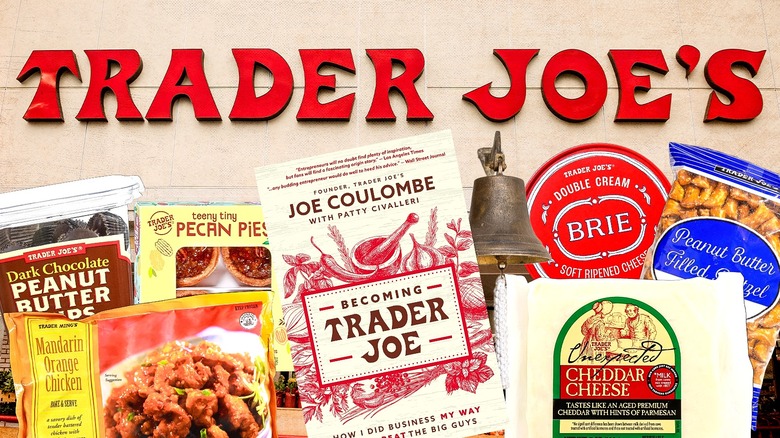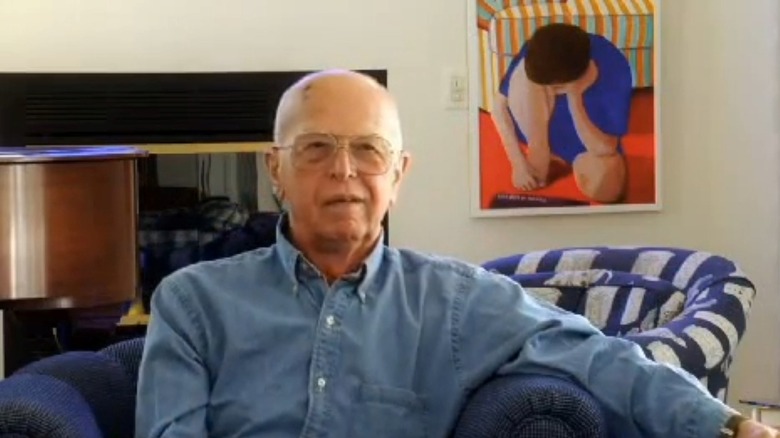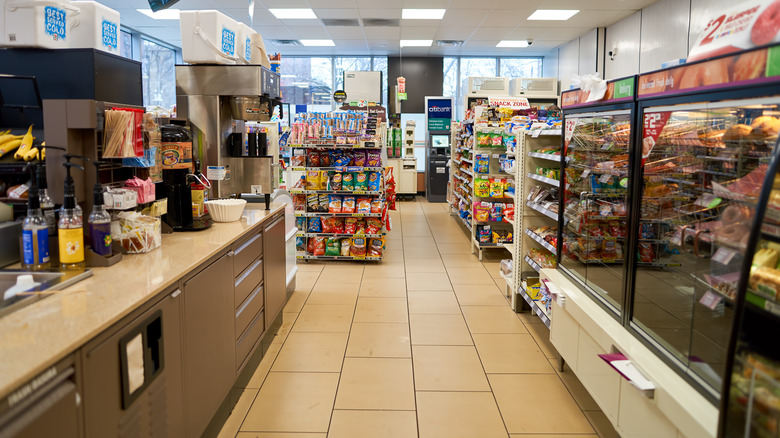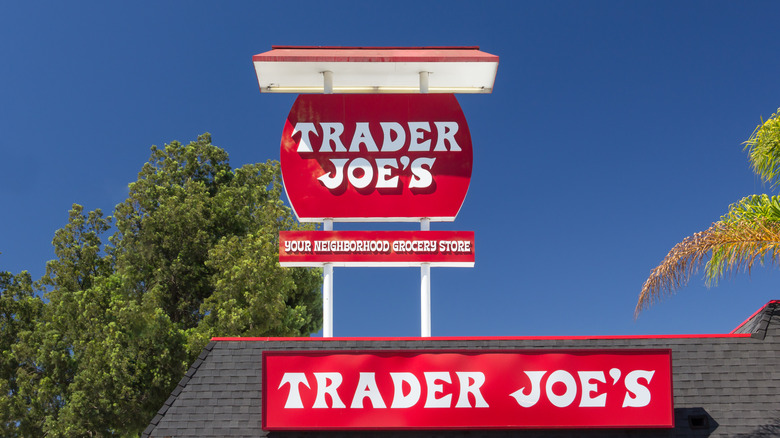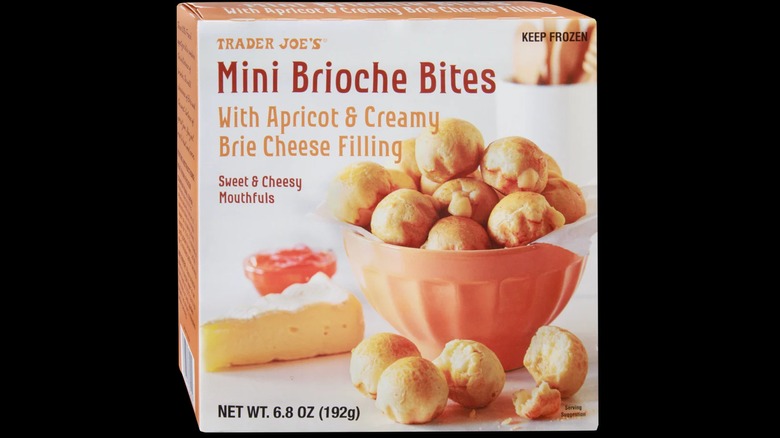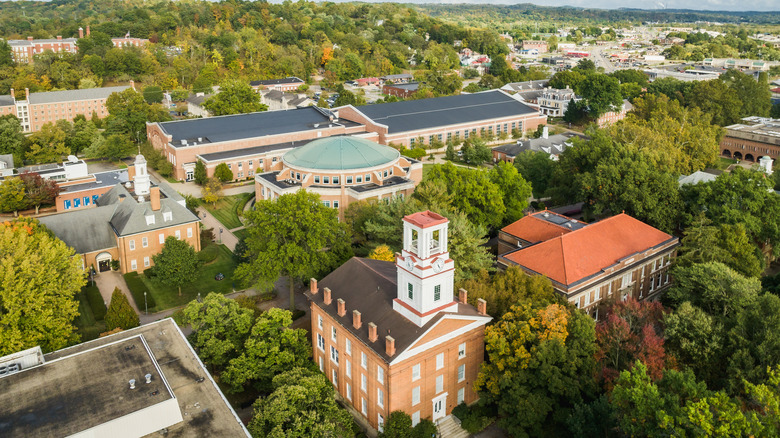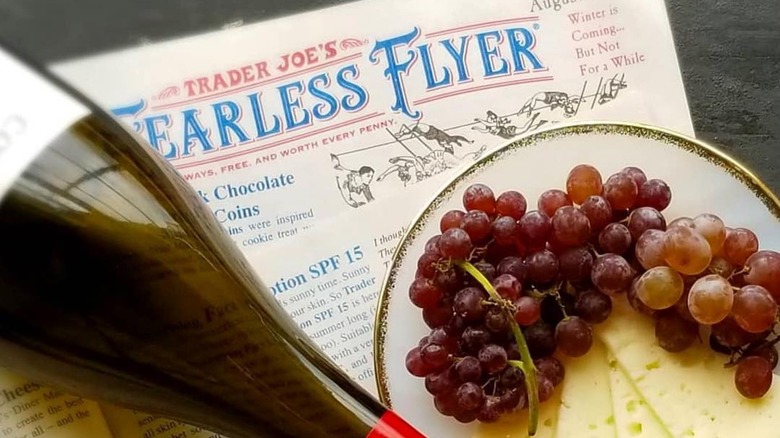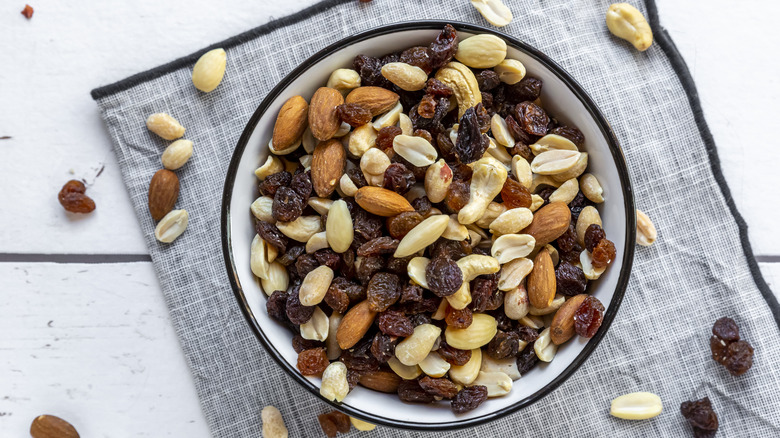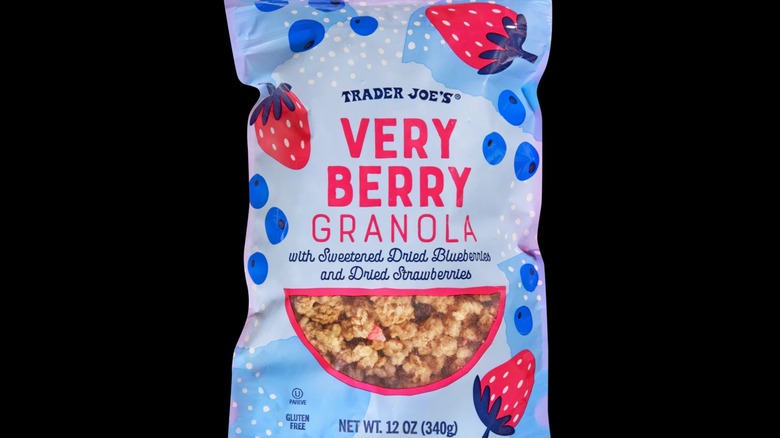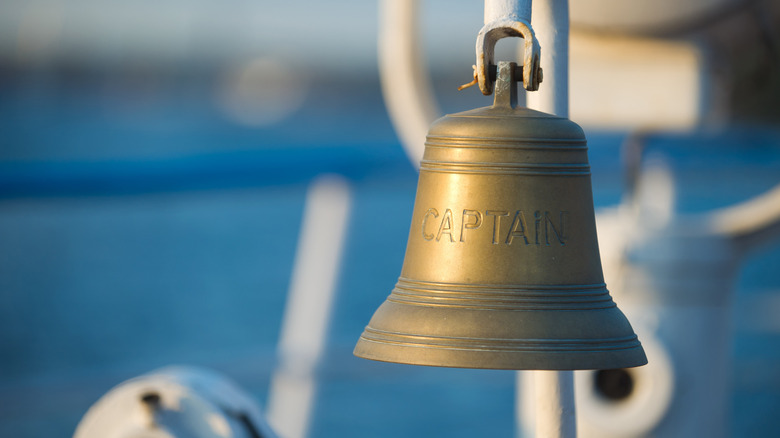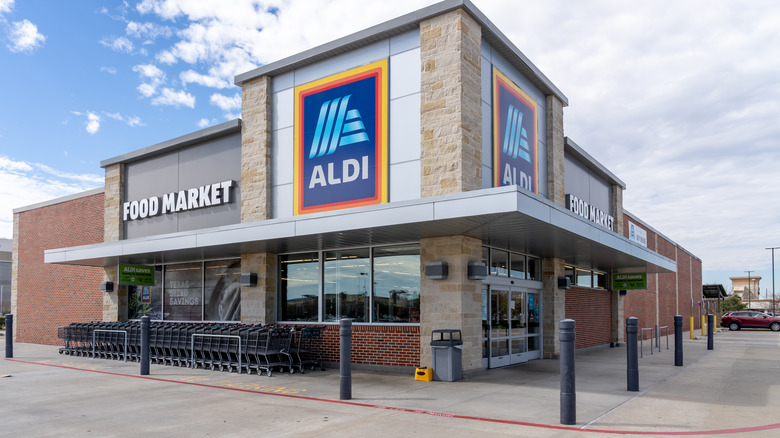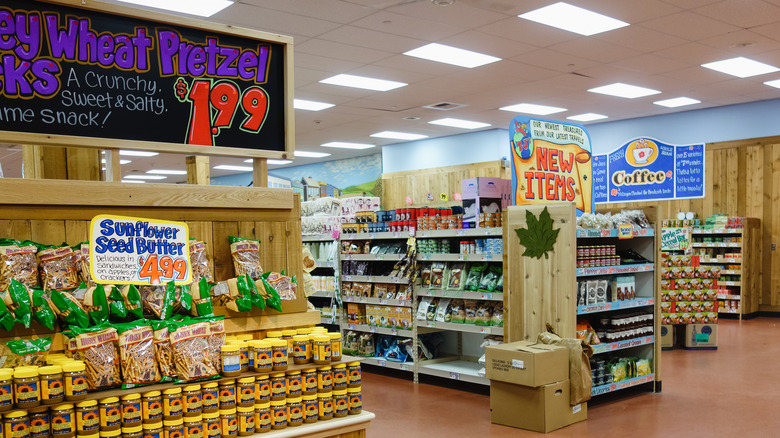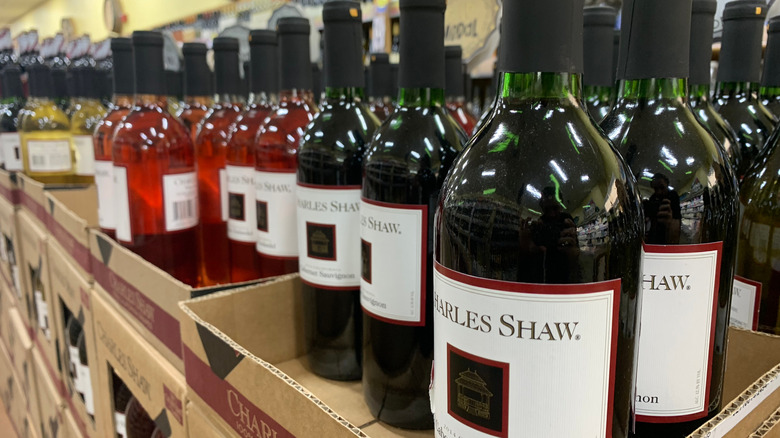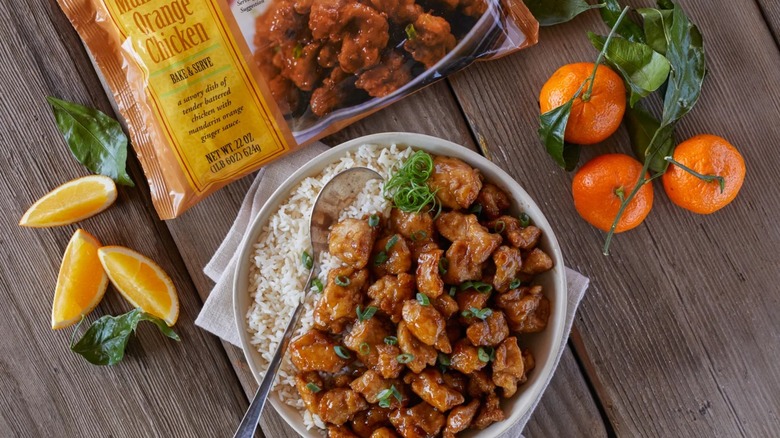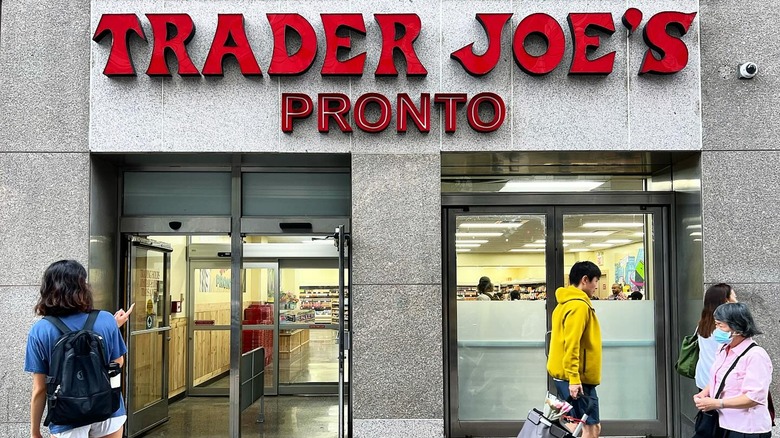A Look Back At The History Of Trader Joe's
We may receive a commission on purchases made from links.
While we know you already love the charm of TJ's and the store's iconic products, you're not a Trader Joe's super fan until you know all the secrets of its history. There are a lot of rumors floating around about the store, but we wanted to get to the bottom of what was really happening throughout the history of the company. So, we sought out a lot of information directly from the horse's mouth. In this case, said horse would be the founder of the company, who wrote a book called "Becoming Trader Joe," published posthumously in 2021. Plus, we contacted Nakia Rohde, the public relations manager for Trader Joe's, who pointed us in the direction of some specific episodes of the Inside Trader Joe's podcast.
It turns out that there's a lot of verifiable information out there about the history of Trader Joe's if you know where to look. But you may not want to have to skim and fast-forward to get to all the interesting bits. So, you can just look back at the history of Trader Joe's along with us here.
Trader Joe was a real person
The real Trader Joe was a California man named Joe Coulombe who was born in San Diego in 1930. He grew up on a Del Mar avocado farm, spent time in the Air Force, and studied economics and business administration at Stanford University. Coulombe was always a salesman at heart, starting out by walking around Stanford neighborhoods selling Kirby vacuum cleaners door-to-door. After college, he became a researcher for Owl-Rexall drug stores before the company asked him to do a test run of a new convenience store chain. Thus, in his late 20s, he started learning the ins and outs of selling groceries at the convenience store level.
Then, a change in circumstances pushed him into creating Trader Joe's when he was only 37. Trader Joe's retired Senior Vice President of Operations, Leroy D. Watson, says in the foreword to Coulombe's biography, "His first rule for new ideas was to always think outside the box, but always consider our customers and employees." What he created when he thought outside the box became legendary. Coulombe died in 2020 at age 89.
Trader Joe's was born from a convenience store chain
Joe Coulombe owned a chain of convenience stores prior to Trader Joe's. He initially started Pronto Market in the Los Angeles area in 1958. They basically looked like 7-Elevens inside, which didn't exist in California yet. But by 1962, Coulombe started worrying about Pronto Markets going bankrupt before it partnered with Adohr Milk Farms. The convenience store chain had been the dairy's biggest milk and ice cream customer. With the capital it received from Adohr, Pronto Markets was able to expand to 16 locations.
In October of 1965, the dairy's president, Merritt Adamson, Jr., met with Coulombe at the Tail O' the Cock bar to deliver some bad news. Adamson had decided he needed to sell the dairy because he was running up against some archaic milk control laws written by his father in another era, and they were causing him to hemorrhage money. Even worse, it turned out that Adamson had sold the dairy to Southland, who owned 7-Eleven Markets. Coulombe told the Los Angeles Times that he knew this "meant the 800-pound gorilla of convenience stores was not only coming to town but now owned my source of capital. So I had to do something different," which turned out to be Trader Joe's.
The first Trader Joe's opened in 1967
Joe Coulombe opened his first Trader Joe's in Pasadena, California, in August of 1967. It was (and still is) located on Arroyo Parkway. To play into the concept of the trader behind the name, Coulombe scrounged up all the marine-themed decor for the store at salvage shops down near the Los Angeles Harbor, where he could get everything for super cheap. So, there were hatch covers sitting on barrels for counters, a ship's bell, and all sorts of nautical decor. In keeping with the South Seas theme, employees started wearing tropical shirts and Bermuda shorts as their uniforms from the very beginning.
That first store was 4,500 square feet, but they would eventually grow to become closer to 8,000 square feet on average in the next couple of decades. However, it was never an ordinary grocery store, as it had a revolving door of products and paid its employees a living wage. Over the years it would develop more, offering gourmet and health food as well as liquor and discount items.
Product discontinuity has always been a part of the plan
The name of the grocery store, Trader Joe's, gives you a glimpse of the strategy Joe Coulombe had of cultivating relationships with his suppliers and making deals. One of the supplier transactions Coulombe had when he owned Pronto Markets helped to lay the groundwork for his future business dealings. It all started when his egg supplier had an overabundance of extra large AA eggs and offered to sell them for the same cost as their large AA eggs. This enabled Pronto Market to sell the extra large eggs for the price of large ones. Since it was a special deal, Coulombe was thrilled that ordinary supermarkets could match his lower price.
With this transaction in mind, Coulombe set out to find other suppliers who could offer him deals, even if it meant that the product was something the store couldn't always carry. With this mindset, product discontinuity was no problem and ultimately became part of the plan when he opened Trader Joe's. These days, TJ's buyers search throughout the world for products they think their customers will like.
Trader Joe's had a certain clientele in mind from the start
Joe Coulombe read about some trends that he found interesting, and he incorporated them into his business plan. The first was an article in Scientific American in 1965 showing more people in the U.S. going to college. There was another article in the Wall Street Journal that hinted that international travel was about to become more affordable with the introduction of the Boeing 747 in 1970. These trends gave him an idea for the future customers he wanted to attract.
With TJ's planning to have items rotate through the store in a discontinuous manner as Coulombe struck new deals, it made sense to market to people with a sense of adventure. Who were these people? Why, they were the educated people who would be taking international flights on adventures to other countries. The more they learned and traveled, he hypothesized, the more likely they would be to want to try a rotation of new products in his store. He told Los Angeles Times that he saw Trader Joe's as being, "for overeducated and underpaid people, for all the classical musicians, museum curators, journalists." So, it's not uncommon to find TJ's in college towns.
It started publishing its Fearless Flyer in 1969
The very first Fearless Flyer advertising newsletter came out in 1969, just two years after the launch of the store. However, it was called the Insider's Report until 1985. At first, the newsletter was written mainly as an educational tool for employees, but customers started asking to see it. In the earliest days, it was called The Insider's Wine Report and was meant as an educational resource about all the new wines TJ's was starting to bring in from around the world, revealing results of wine taste tests.
Then, a new Insider's Food Report was launched to do the same for TJ's food. The layout of the Fearless Flyer was similar to that of Consumer Reports, with a writing style that was meant to be like New York magazine. Because the store was operating on a budget, the artwork was literally cut out of non-copyrighted pre-1906 Punch Magazines and Harper's magazines and taped onto the master copy of each newsletter. Today, the Fearless Flyer still uses old-fashioned artwork and maintains a sort of whimsical folksiness as it introduces customers to what's new or returning to the store. It's available by mail or email by subscription request.
Trader Joe's jumped on the health food trend in 1971
The founder of Trader Joe's continuously kept his eyes open for new trends, and in 1971, that new trend was health food. Thus, the grocery store chain decided to focus on selling healthier products that year. Rather than focus on selling organic products, the store focused on selling food that doesn't require as much label reading. For example, you won't find artificial colors, artificial preservatives, partially hydrogenated oils, or MSG in TJ's products. This makes shopping a lot easier if you're trying to avoid these ingredients.
Some of the early health food items were granola and orange juice squeezed before your very eyes. Then, there were nuts, dried foods, raw milk, and vitamins. If those sound a bit hippie-ish, it's because TJ's hired a hippie from a local university to give insight into the health food lingo of the era. These days, there are even more health food options and foods catering to special dietary needs.
It switched largely to private-label items in 1972
Trader Joe's buys directly from suppliers around the world who can offer the best deal on quality products. These products then get the TJ's label. However, it didn't start out selling private-label goods. The first private-label item appeared in 1972, and it was one of its health foods: granola.
At first, it was mainly things that didn't have a lot of brand recognition, like nuts and dried fruits, that got a private label. As the product selection grew, they often had clever names that were meant to appeal to the type of people shopping there. For example, you might find Sir Isaac Newtons in the dessert section. In the early days, products were often in clear packaging with word-only labels. Because the uncooked products didn't always look that great, some packages started to include photos. These days, the packaging is a work of art and often contains humor as well.
Trader Joe's doesn't carry many name-brand products at all. In fact, in the 15th episode of the Inside Trader Joe's podcast, TJ's executive vice president for marketing and merchandising, Mitch Heeger, said that 85% to 95% of its products are private label now. Part of the reason is that Trader Joe's private label became trusted enough by customers to be preferred over many of the leading name brands. Interestingly, some of TJ's branded products are produced by companies you might recognize.
The bell-ringing tradition started in 1975
As we mentioned previously, the first store had a ship's bell as part of its decor. However, the bell-ringing tradition at Trader Joe's didn't actually start until 1975. Ringing a captain's bell is in keeping with the nautical theme. Plus, it eliminated the need for a PA system back when the store was operating on a much smaller budget.
The meanings of the Trader Joe's bell rings are no secret. If there are lots of customers standing in the checkout line and an employee needs to open another register, you'll hear one bell. You'll hear two rings if someone at one of the checkout counters has a question. If a question or situation calls for a manager, three bells will send them up front. There are also some four-bell situations that require everyone to come up to the front of the store to help customers.
Its relationship with Aldi didn't exist until 1979
If you've been a Trader Joe's fan for long at all, you've probably heard the rumors that they're owned by the same company. There's a bit of truth to the connection, but the story is a bit more complicated. Joe Coulombe sold Trader Joe's to Aldi Nord in 1979 – kind of.
Aldi split in half in the 1960s after a disagreement between brothers Karl and Theodore Albrecht over whether they should sell cigarettes or not, with Karl taking Aldi Süd and Theo taking Aldi Nord. In 1975, Karl bought a supermarket chain in Iowa called Benner Tea Co., which he strived to turn into something like an Aldi. Not to be outdone, the other brother, Theo, decided to find a grocery store chain in the U.S. with locations he could convert into Aldis. When the company first contacted Joe Coulombe about buying Trader Joe's for this purpose, he wasn't interested. However, an agreement was finally reached such that Aldi agreed to not convert the stores or change the way Trader Joe's operated. Plus, the proposed purchase price had tripled. Wisely, the company asked Coulombe to stick around as a consultant until 1989, and he did.
Technically, TJ's never belonged to Aldi Nord. The two are separate entities and independent. Rather than collect dividends, the stock from TJ's goes into a family trust. The recipients of money in that trust fund were initially Theo's sons, Theodore Jr. and Bertholdt Albrecht, whose families currently have partial ownership of Aldi Nord.
Trader Joe's didn't make it to the East Coast until the 1990s
In the late 1990s, Trader Joe's opened up its first locations on the East Coast. In those early days, you could only find locations of the store in a 500-mile range between Boston and Washington, D.C. The South Seas themes all remained, but some of the products changed to accommodate the particularities of the customers in the region. For example, there was a need for more kosher products. However, the culture of friendly cashiers remained the same, which took a bit of getting used to for some of the more standoffish East Coast customers.
The new CEO after Joe Coulombe left, John Shields, had been his college roommate at Stanford University. So, he understood the vision of the grocery store well and was looking for locations for new stores where people were educated enough to appreciate all the product offerings. As the company has expanded throughout the U.S. over the years, it has gravitated toward more educated areas. Donny, the company's vice president of real estate and construction revealed on Episode 52 of the Inside Trader Joe's podcast that TJ's only accepts about one out of every 10 new store location sites it considers. Even if TJ's is considering 200 new locations, they won't all make the cut. The company couldn't support that many new sites at a time anyway.
Two Buck Chuck became a fixture at Trader Joe's in 2002
Before you ever visited your first Trader Joe's, you likely heard tales of the magical Two Buck Chuck that Trader Joe's sells — $2 bottles of Charles Shaw wine. These cheap bottles first appeared on shelves in 2002. And what's kept it popular all these years, is not only the price but also that it's not the headache-inducing, cheap-tasting wine you likely expected from the price tag. Of course, with inflation, Two Buck Chuck is now more like Five Buck Chuck – almost Six Buck Chuck.
In the 1990s, Charles Shaw wine was a high-end wine that sold for $13.50 a bottle and it came out of Napa Valley. However, a series of misfortunes brought the winery to its knees, including paraffin-tainted wine, an overproduction of Burgundy-style wine, and root louse destroying 50 acres of vines. Eventually, the company went bankrupt, but the trade name was purchased by Fred Franzia, who owns Franzia and Bronco wines. Suddenly, wine with the Charles Shaw name was being sold for just $1.99. And the grapes were coming from Central Valley, where they were cheaper, even though the label craftily says that it's still bottled in Napa Valley.
The Customer Choice Award contest started in 2009
Every January, Trader Joe's announces its Customer Choice Awards, with the first announcements occurring in 2009. These are the products that customers vote as being their favorites for the years. There's an overall winner as well as top prizes in categories like beverages, cheese, produce, and sweet treats. So, if you don't know what to get, these lists give you an idea of what everyone loves.
There are some products that are so epic that they were inducted into the Product Hall of Fame and are no longer counted in the Customer Choice Award vote (because it would be unfair to all the other products). Some of the legendary products that customers buy again and again include Trader Joe's Mandarin Orange Chicken, Dark Chocolate Peanut Butter Cups, Peanut Butter Filled Pretzel Nuggets, Unexpected Cheddar Cheese, and Soy Chorizo.
Trader Joe's tried out a Trader Joe's Pronto model in 2024
In March of 2024, Trader Joe's reached way back into its history and borrowed from the name of Joe Coulombe's first convenience store to create a new Trader Joe's Pronto store. It's a 2,800-square-foot convenience-style store in Union Square in New York City. Trader Joe's Pronto is located in the same spot that once housed the Trader Joe's Wine Shop, which closed in 2022.
Nakia Rohde, the public relations manager for Trader Joe's, explained, "Trader Joe's Pronto delivers customers the same great values in a smaller space that offers a smaller assortment of products. Using this space in this way makes the most sense for our customers and our Crew Members." It offers the type of products people in the area tend to look for, like meals and foods that are ready to eat or made to heat and eat. However, don't expect to see Trader Joe's Prontos elsewhere. Rohde told us, "We don't have any plans to open additional Trader Joe's Pronto locations."
